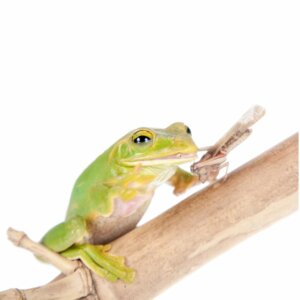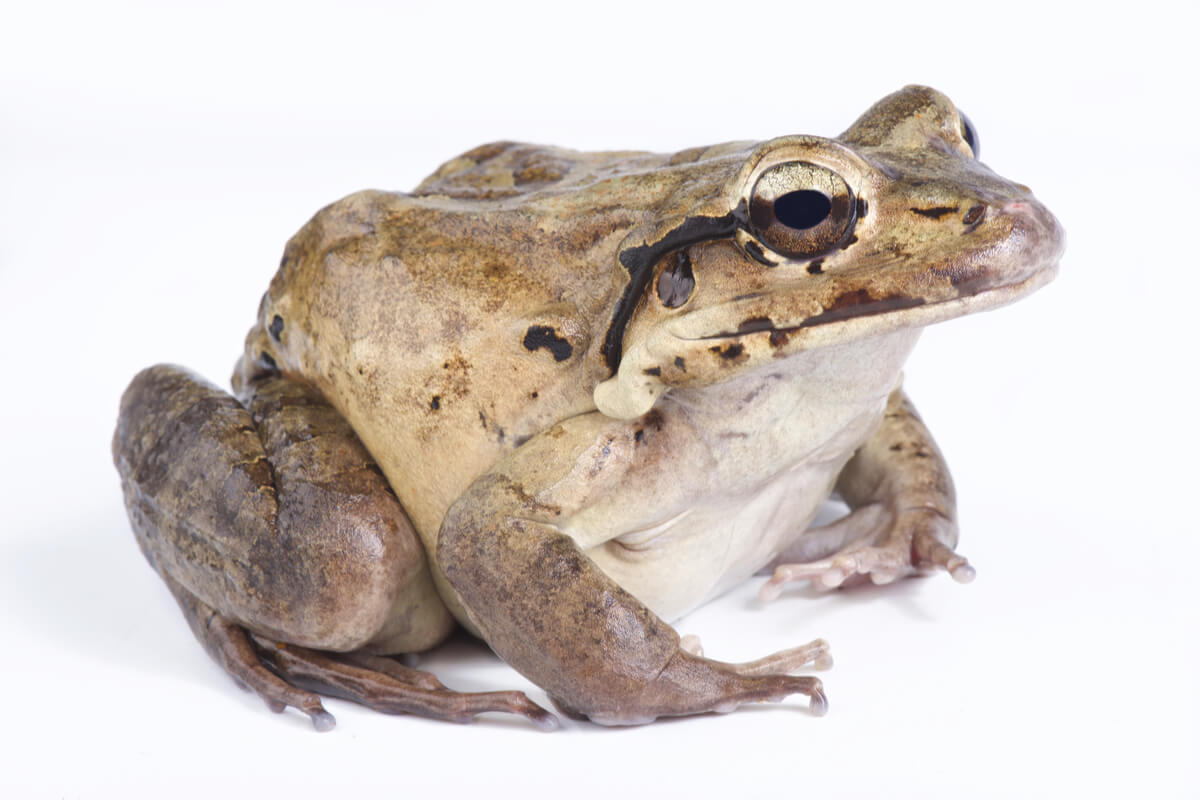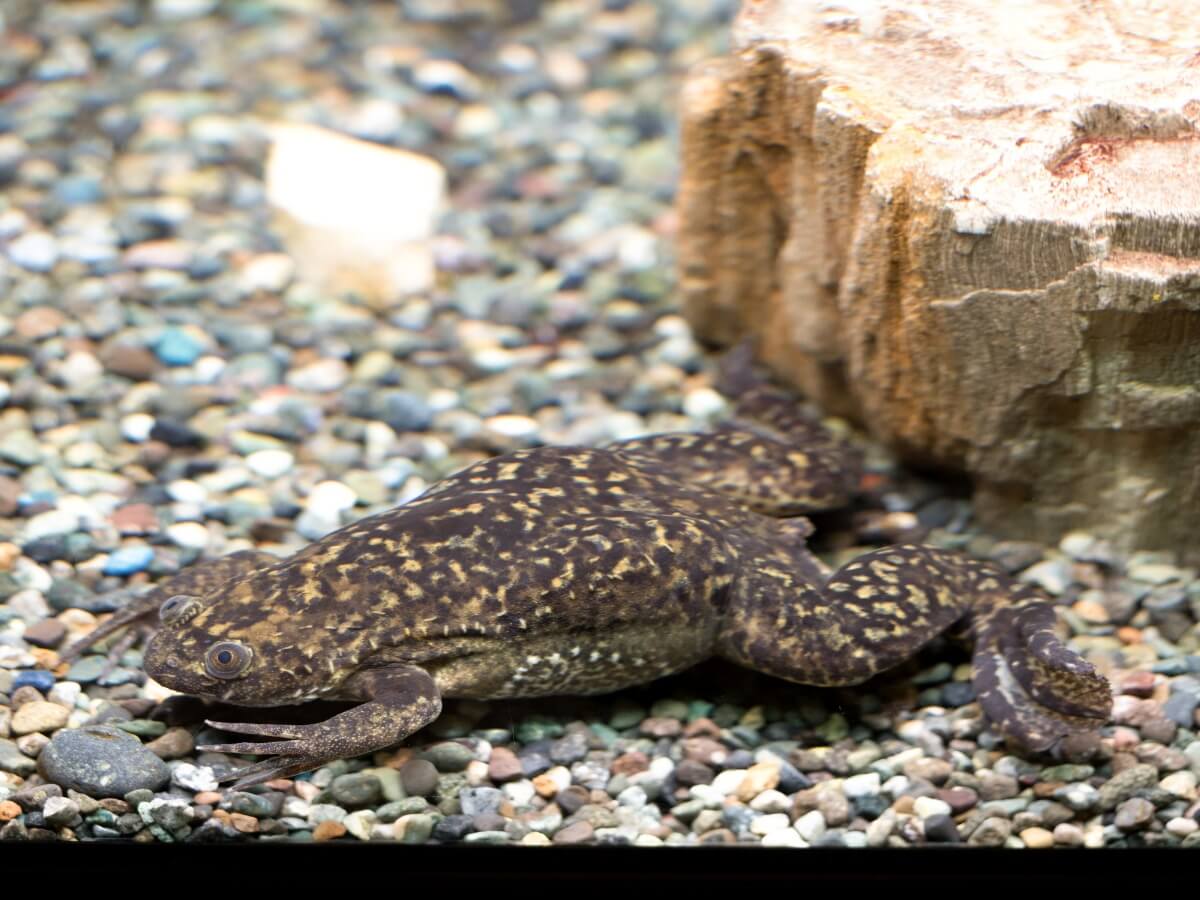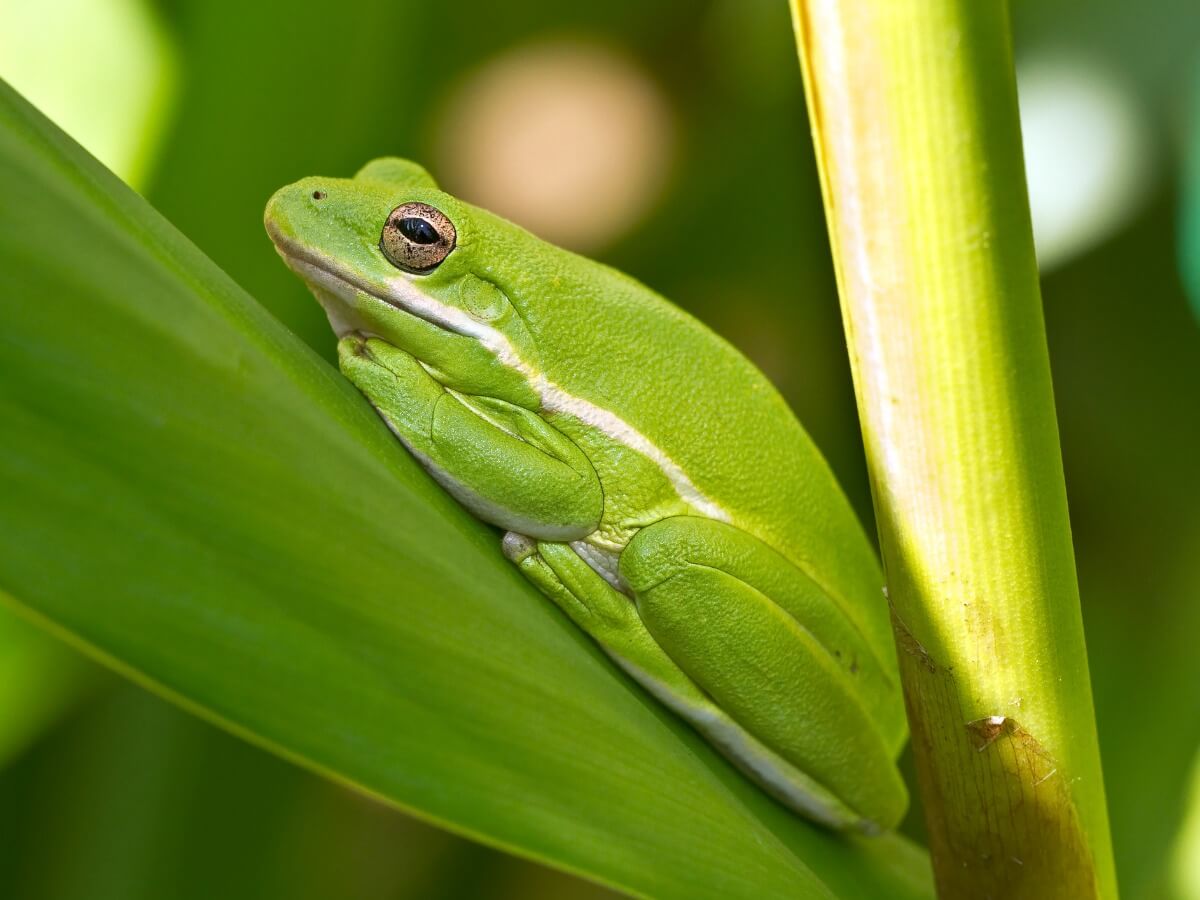What Do Frogs Eat?


Written and verified by the biologist Samuel Sanchez
Frogs are amphibians that seem very cute thanks to their small size, bulging eyes and apparent fragility. They have very thin skin and a large mouth when compared to the rest of their body, which gives them a comical shape worthy of a cartoon. However, there’s nothing adorable about their eating habits: would you want to know what frogs eat?
These animals are eminently predatory, although their eating habits change throughout their lives, with notable differences being observed between before and after metamorphosis. Next, we’ll tell you everything you need to know about the diet of these friendly animals. Don’t miss it.
What are frogs?
Before diving into a frog’s menu, we need to find out a few basics about them. Frogs belong to the Amphibia class, which also includes salamanders, newts, and caecilians. They’re specifically anuran amphibians, as they don’t have a tail and their body is flat, unlike Urodelas.
It’s estimated that 88% of amphibians are classified as anurans, a group that includes more than 7,100 species divided into 55 families. At this point, it should be noted that a frog is every species within the Anura order, regardless of its vital characteristics or the roughness of its skin. Indeed, differentiating between “toad” and “frog” by their bodily features is wrong from a scientific point of view.
It is often said that frogs are slimmer, with more obvious hind limbs, smoother skin, and eminently aquatic habits. On the other hand, toads have rougher skin, are flatter and move through drier ecosystems. This isn’t entirely true, as some “toads” (such as the genus Atelopus ) have a smooth and slender shape, almost equal to that of a typical “frog”.
Thus, we can say that the only “true toads” are those belonging to the Bufonidae family, while all other anurans could be considered as frogs, although this isn’t true at the taxonomic level either. Complicated eh?!
The groups that comprise the majority of typical “frogs” are the following: Craugastoridae (850 species), Hylidae (724 species) and Microhylidae (688 species).

What do frogs eat?
Now that you know how these types of amphibians are defined at a taxonomic level, we’re ready to answer the question of what frogs eat. We’ll distinguish their dietary choices according to their life stage, as the diet of a tadpole is totally different to that of an adult individual. Let’s go!
What do tadpoles eat?
The term “tadpole” covers the larval stage of anuran amphibians. These larvae are completely aquatic, they have gills covered by skin (forming an opercular chamber) and they have a very evident tail, with which they help themselves to swim with lateral wave movements. The size of tadpoles varies greatly between species.
Most tadpoles are herbivores and feed on algae that accumulate on rocks and sediments from rivers, lakes, or perishable water sources. They can also feed on decomposing animal organic matter, such as vertebrate chunks or drowned insects. They have a very elongated spiral intestine, which allows them a greater degree of nutritional absorption.
Some larvae of the Microhylidae family feed by filtration, swimming through the water column and eating the microscopic plankton in suspension. On the other hand, some of the few frogs that have predatory tadpoles are those of the Ceratophryidae family. Thanks to their huge mouths, they’re capable of eating insects, small fish, and arthropods.
What do adult frogs eat?
The answer this time around is much simpler: all frogs are predators. This means that they feed on live animals, hunting them generally using a sit and wait type strategy. As they’re very clumsy beings, amphibians tend to stay still and wait for prey to pass in front of them, trapping it with their sticky tongues or other mechanisms.
Be that as it may, a frog’s diet will vary drastically depending on the environment it inhabits. We’ll now take a closer look at the dietary choices of these anurans depending on the habitat they live in, using some specific species as examples.
Feeding of aquatic frogs
The quintessential water frog is Xenopus laevis. This anuran never leaves the water, although it can withstand quite long periods of desiccation by burying itself in the mud. This species, in particular, is predatory and scavenger, as it takes all the meat that it can find, whether it’s alive or dead.
Xenopus laevis is guided by its sensory lateral line, its extremely sensitive fingers, and its sense of smell to detect its prey. Thanks to the hyobranchial pump that it has in its mouth, it sucks in its victims by “swallowing” water without much difficulty. It mainly feeds on fish, insect larvae, fallen arthropods, and pieces of dead animals.

Feeding of land frogs
So, is there any food that both aquatic and terrestrial frogs eat? If we take the Rana temporaria species as an example, we’ll see that this friendly anuran feeds on insect larvae, isopods, spiders, snails and worms. In addition to aquatic invertebrates, it also resorts to terrestrial invertebrates that hide under rocks and in the substrate.
The diet of this species largely depends on the time of year.
Tree frog diet
Unlike the cited examples, some anurans spend much of their time on tree and shrub branches near water sources, Hyla cinerea being one of the most common examples. These frogs, due to their biological niche, feed mainly on flies, mosquitoes and other winged insects.

As you can see, answering what frogs eat is a bit more complex than you might initially think. In summary, tadpoles are usually herbivores, while all anurans are predators of arthropods and small vertebrates, although their eating habits vary according to their geographic location and their ecosystem.
Frogs are amphibians that seem very cute thanks to their small size, bulging eyes and apparent fragility. They have very thin skin and a large mouth when compared to the rest of their body, which gives them a comical shape worthy of a cartoon. However, there’s nothing adorable about their eating habits: would you want to know what frogs eat?
These animals are eminently predatory, although their eating habits change throughout their lives, with notable differences being observed between before and after metamorphosis. Next, we’ll tell you everything you need to know about the diet of these friendly animals. Don’t miss it.
What are frogs?
Before diving into a frog’s menu, we need to find out a few basics about them. Frogs belong to the Amphibia class, which also includes salamanders, newts, and caecilians. They’re specifically anuran amphibians, as they don’t have a tail and their body is flat, unlike Urodelas.
It’s estimated that 88% of amphibians are classified as anurans, a group that includes more than 7,100 species divided into 55 families. At this point, it should be noted that a frog is every species within the Anura order, regardless of its vital characteristics or the roughness of its skin. Indeed, differentiating between “toad” and “frog” by their bodily features is wrong from a scientific point of view.
It is often said that frogs are slimmer, with more obvious hind limbs, smoother skin, and eminently aquatic habits. On the other hand, toads have rougher skin, are flatter and move through drier ecosystems. This isn’t entirely true, as some “toads” (such as the genus Atelopus ) have a smooth and slender shape, almost equal to that of a typical “frog”.
Thus, we can say that the only “true toads” are those belonging to the Bufonidae family, while all other anurans could be considered as frogs, although this isn’t true at the taxonomic level either. Complicated eh?!
The groups that comprise the majority of typical “frogs” are the following: Craugastoridae (850 species), Hylidae (724 species) and Microhylidae (688 species).

What do frogs eat?
Now that you know how these types of amphibians are defined at a taxonomic level, we’re ready to answer the question of what frogs eat. We’ll distinguish their dietary choices according to their life stage, as the diet of a tadpole is totally different to that of an adult individual. Let’s go!
What do tadpoles eat?
The term “tadpole” covers the larval stage of anuran amphibians. These larvae are completely aquatic, they have gills covered by skin (forming an opercular chamber) and they have a very evident tail, with which they help themselves to swim with lateral wave movements. The size of tadpoles varies greatly between species.
Most tadpoles are herbivores and feed on algae that accumulate on rocks and sediments from rivers, lakes, or perishable water sources. They can also feed on decomposing animal organic matter, such as vertebrate chunks or drowned insects. They have a very elongated spiral intestine, which allows them a greater degree of nutritional absorption.
Some larvae of the Microhylidae family feed by filtration, swimming through the water column and eating the microscopic plankton in suspension. On the other hand, some of the few frogs that have predatory tadpoles are those of the Ceratophryidae family. Thanks to their huge mouths, they’re capable of eating insects, small fish, and arthropods.
What do adult frogs eat?
The answer this time around is much simpler: all frogs are predators. This means that they feed on live animals, hunting them generally using a sit and wait type strategy. As they’re very clumsy beings, amphibians tend to stay still and wait for prey to pass in front of them, trapping it with their sticky tongues or other mechanisms.
Be that as it may, a frog’s diet will vary drastically depending on the environment it inhabits. We’ll now take a closer look at the dietary choices of these anurans depending on the habitat they live in, using some specific species as examples.
Feeding of aquatic frogs
The quintessential water frog is Xenopus laevis. This anuran never leaves the water, although it can withstand quite long periods of desiccation by burying itself in the mud. This species, in particular, is predatory and scavenger, as it takes all the meat that it can find, whether it’s alive or dead.
Xenopus laevis is guided by its sensory lateral line, its extremely sensitive fingers, and its sense of smell to detect its prey. Thanks to the hyobranchial pump that it has in its mouth, it sucks in its victims by “swallowing” water without much difficulty. It mainly feeds on fish, insect larvae, fallen arthropods, and pieces of dead animals.

Feeding of land frogs
So, is there any food that both aquatic and terrestrial frogs eat? If we take the Rana temporaria species as an example, we’ll see that this friendly anuran feeds on insect larvae, isopods, spiders, snails and worms. In addition to aquatic invertebrates, it also resorts to terrestrial invertebrates that hide under rocks and in the substrate.
The diet of this species largely depends on the time of year.
Tree frog diet
Unlike the cited examples, some anurans spend much of their time on tree and shrub branches near water sources, Hyla cinerea being one of the most common examples. These frogs, due to their biological niche, feed mainly on flies, mosquitoes and other winged insects.

As you can see, answering what frogs eat is a bit more complex than you might initially think. In summary, tadpoles are usually herbivores, while all anurans are predators of arthropods and small vertebrates, although their eating habits vary according to their geographic location and their ecosystem.
All cited sources were thoroughly reviewed by our team to ensure their quality, reliability, currency, and validity. The bibliography of this article was considered reliable and of academic or scientific accuracy.
- Hirai, T. (2002). Ontogenetic change in the diet of the pond frog, Rana nigromaculata. Ecological Research, 17(6), 639-644.
- Beard, K. H. (2007). Diet of the invasive frog, Eleutherodactylus coqui, in Hawaii. Copeia, 2007(2), 281-291.
- Olson, C. A., & Beard, K. H. (2012). Diet of the introduced greenhouse frog in Hawaii. Copeia, 2012(1), 121-129.
- Parker, M. L., & Goldstein, M. I. (2004). Diet of the Rio Grande leopard frog (Rana berlandieri) in Texas. Journal of Herpetology, 38(1), 127-130.
This text is provided for informational purposes only and does not replace consultation with a professional. If in doubt, consult your specialist.








